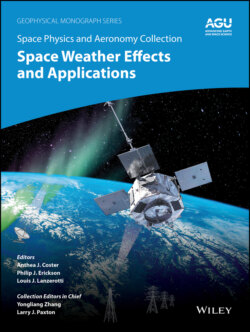Space Physics and Aeronomy, Space Weather Effects and Applications

Реклама. ООО «ЛитРес», ИНН: 7719571260.
Оглавление
Группа авторов. Space Physics and Aeronomy, Space Weather Effects and Applications
Table of Contents
List of Tables
List of Illustrations
Guide
Pages
Geophysical Monograph Series
Space Physics and Aeronomy Collection Volume 5 Geophysical Monograph 262. Space Weather Effects and Applications
LIST OF CONTRIBUTORS
PREFACE
Introduction: Space Weather Underlies Reliable Technologies
REFERENCES
1 Effects of Space Radiation on Contemporary Space‐Based Systems I: Single Event Upsets, Spacecraft Charging, Degradation of Electronics, and Attenuation on Fiber Cabling
ABSTRACT
1.1. INTRODUCTION
1.2. OVERVIEW OF SPACE RADIATION PROPERTIES
1.3. SPACE RADIATION EFFECTS
1.4. DISCUSSION AND CONCLUSIONS
REFERENCES
2 Effects of Space Radiation on Contemporary Space‐Based Systems II: Spacecraft Internal and External Charging and Discharging Effects
ABSTRACT
2.1. SURFACE CHARGING
2.2. INTERNAL (DEEP) CHARGING
2.3. PATH FORWARD
REFERENCES
3 Effects of Space Radiation on Humans in Space Flight
ABSTRACT
3.1. INTRODUCTION
3.2. THE SPACE WEATHER ENVIRONMENT
3.3. RADIATION QUANTITIES, UNITS, AND SYMBOLS
3.4. RADIATION EFFECTS ON HUMANS
3.4.1. Radiation Effects at the Cellular Level
3.4.2. Radiation Effects on Blood‐Forming Organs
3.4.3. Radiation Effects on the Gastrointestinal System
3.4.4. Radiation Effects on the Cardiovascular/Central Nervous Systems
3.4.5. Radiation Effects on the Skin
3.4.6. Radiation Effects on the Eye Lens
3.4.7. Radiation Carcinogenesis
3.5. RADIATION LIMITS
3.5.1. National Aeronautics and Space Administration Radiation Limits (USA)
3.5.2. European Space Agency
3.5.3. Russian Space Agency
3.5.4. Canadian Space Agency
3.5.5. Japan Aerospace Exploration Agency
3.6. REPRESENTATIVE SEP EVENT RADIATION EXPOSURES
3.6.1. SEP Events of 24 August 1998 and 17 May 2012
3.6.2. SEP Events of 14 July 2000, 4 November 2001, and 28 October–2 November 2003
3.6.3. SEP Events of August 1972 and 18–24 October 1989
3.6.4. Extreme SEP Event of 775 AD
3.7. SUMMARY AND CONCLUSIONS
REFERENCES
4 Space Weather Radiation Effects on High‐Altitude/‐Latitude Aircraft
ABSTRACT
4.1. INTRODUCTION
4.2. THE PHYSICS OF ATMOSPHERIC RADIATION. 4.2.1. Galactic Cosmic Rays
4.2.2. Heliospheric GCR Transport
4.2.3. Solar Energetic Particles
4.2.4. Radiation Belt Precipitated Charged Particles
4.2.5. Magnetospheric Transport
4.2.6. Atmosphere Transport
4.2.7. Radiation Dosimetry
4.2.8. Avionics
4.2.9. Models
4.3. MEASUREMENTS OF THE RADIATION ENVIRONMENT. 4.3.1. Instrumentation
Tissue Equivalent Proportional Counter (TEPC)
Automated Radiation Measurements for Aerospace Safety (ARMAS)
Liulin
Active Tissue Equivalent Dosimeter (ATED)
4.3.2. Campaigns
4.4. REGULATORY ACTIVITIES. 4.4.1. International
4.4.2. United States
4.5. CONCLUSIONS
REFERENCES
5 Remaining Issues in Upper Atmosphere Satellite Drag
ABSTRACT
5.1. INTRODUCTION
5.2. BACKGROUND
5.3. THE PHYSICS OF ATMOSPHERIC DRAG ON SPACECRAFT
5.4. THE LOWER REGISTER (100–500 KM ALTITUDE) 5.4.1. Rarefied Gas Dynamics
5.4.2. Gas‐Surface Interactions
5.5. THE UPPER REGISTER (500–1000 KM)
5.5.1. Rarefied Gas Dynamics
5.5.2. Gas‐Surface Interactions
5.6. SOLAR AND GEOMAGNETIC DRIVERS
5.6.1. Legacy Drivers (F10.7 and Ap)
5.6.2. Contemporary Drivers (S10, M10, Y10, Dst)
5.6.3. F10.7 Proxy
5.6.4. S10.7 Index
5.6.5. M10.7 Proxy
5.6.6. Y10.7 Index
5.6.7. Geomagnetic Indices
5.7. CONCLUSIONS
ACKNOWLEDGMENTS
REFERENCES
6 Solar Radio Burst Effects on Radio‐ and Radar‐Based Systems
ABSTRACT
6.1. INTRODUCTION
6.2. CAUSE AND GENERAL CHARACTERISTICS OF EXTREME SOLAR RADIO NOISE
6.2.1. Origin of the Radio Emission and Types of Emission
6.2.2. Frequency Distribution and Polarization Characteristics of Radio Noise
6.3. OCCURRENCE STATISTICS OF SOLAR RADIO BURSTS. 6.3.1. Expected Flux Density Threshold for Effects
6.3.2. Data Sources and Limitations
6.3.3. Flux Density Distribution and Dependence on Frequency
6.3.4. Extreme Events
6.4. NOTABLE SOLAR RADIO BURST IMPACTS REPORTED IN THE LITERATURE. 6.4.1. The May 1967 Great Storm and the Cold War
6.4.2. A Reported Impact on a Cellular Telephone System
6.4.3. The 6 December 2006 Solar Radio Burst
6.4.4. Solar Radio Burst Effects on Air Traffic Control Radar
6.5. CONCLUSIONS
ACKNOWLEDGMENTS
REFERENCES
7 Space Weather Influences on HF, UHF, and VHF Radio Propagation
ABSTRACT
7.1. INTRODUCTION
7.2. THE IONOSPHERE
7.3. RADIO PROPAGATION THROUGH AN IONIZED MEDIUM
7.3.1. Magnetic Field Effects on Propagation
7.3.2. Vertical HF Sounding
7.4. IONOSPHERIC MORPHOLOGY AND DISTURBANCES
7.4.1. Traveling Ionospheric Disturbances (TIDs)
7.4.2. Equatorial Propagation
7.4.3. Sporadic E
7.5. SOLAR STORM EFFECTS
7.6. SPACE WEATHER EFFECTS ON UHF/VHF AND HF USER APPLICATIONS. 7.6.1. Ground‐Based Applications
7.6.2. Satellite/Transionospheric Applications
7.7. SUMMARY AND OUTSTANDING QUESTIONS
ACKNOWLEDGMENTS
REFERENCES
8 GNSS/GPS Degradation from Space Weather
ABSTRACT
8.1. INTRODUCTION
8.1.1. The Ionosphere
8.1.2. The Troposphere
8.2. GNSS SPACE WEATHER EFFECTS, MONITORING, AND APPLICATIONS. 8.2.1. Space Weather Effects
Low‐latitude space weather effects
Midlatitude space weather effects
High latitudes
8.3. SCIENTIFIC APPLICATION OF GNSS. 8.3.1. Space Weather Monitoring
Monitoring the horizontal structure of ionosphere with GPS (2D TEC map)
Monitoring the 3D structure of ionosphere and plasmasphere using tomographic reconstruction technique
Longitudinal dependence of space weather–associated scintillation measurements
8.4. GNSS APPLICATIONS
8.5. SUMMARY
REFERENCES
9 Geomagnetic Field Impacts on Ground Systems
9.1. BACKGROUND FOR POWER SYSTEMS
9.2. GEOMAGNETIC STORM ENVIRONMENT MODEL
9.3. GROUND MODELS AND ELECTRIC FIELD CALCULATION
9.4. US ELECTRIC POWER GRID CIRCUIT MODEL
9.5. TRANSFORMER AND AC POWER GRID PERFORMANCE MODEL
9.6. THE EVOLVING VULNERABILITY OF ELECTRIC POWER GRIDS AND IMPLICATIONS FOR HISTORICALLY LARGE STORMS
9.7. SIMULATIONS AND REVIEW OF STORM IMPACTS ON THE US POWER GRID
9.7.1. Substorm Interval 7:40–8:00 UT
9.7.2. Substorm Interval 10:50–12:00 UT
9.7.3. Substorm Interval 21:20–22:30 UT
9.7.4. Substorm Interval 0:30–2:00 UT 14 March 1989
9.8. DESCRIPTIONS OF DIFFERENT TYPES OF GEOMAGNETIC STORMS
9.9. IMPACTS ON OTHER TYPES OF GROUND SYSTEMS
REFERENCES
APPENDIX: BIBLIOGRAPHY
Epilogue: The Road to Future Progress in Space Weather Understanding
INDEX
WILEY END USER LICENSE AGREEMENT
Отрывок из книги
212 The Early Earth: Accretion and Differentiation James Badro and Michael Walter (Eds.)
.....
236 Quantifying Uncertainty in Subsurface Systems Celine Scheidt, Lewis Li, and Jef Caers (Eds.)
237 Petroleum Engineering Moshood Sanni (Ed.)
.....